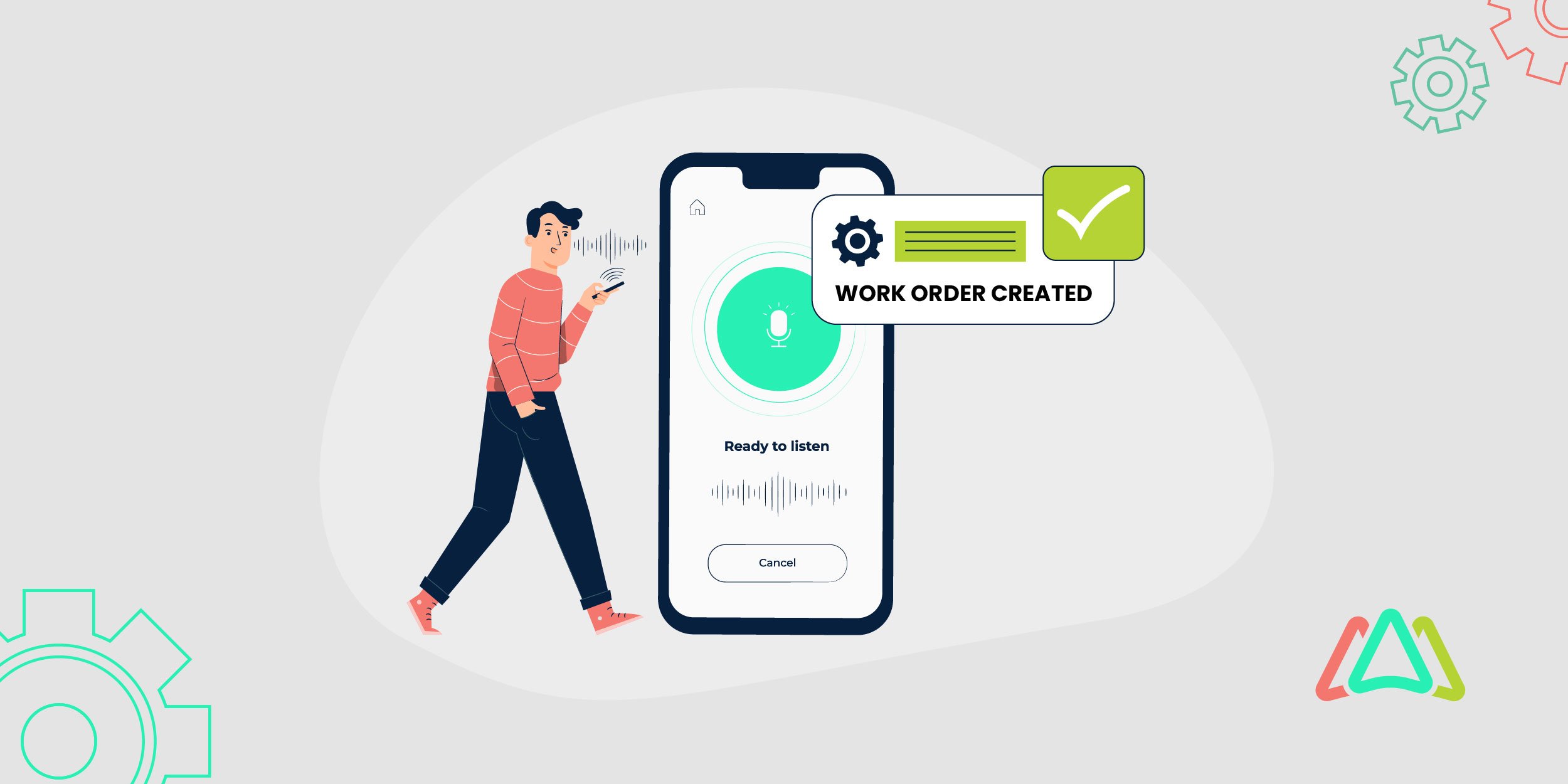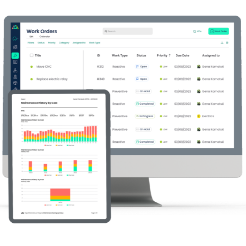
NLP Technology and How It Helps Improve Work Order Management
Picture this: a maintenance technician inspects a complex pump system. Instead of typing a detailed report on a tiny screen with greasy hands, he simply speaks into the mic on his phone while logged into his CMMS mobile app and says, "Create a work order for Pump 3. There is a high-pitched noise coming from the bearing. It likely needs replacement based on a similar issue last month." The system instantly creates a properly formatted work order, tags it as high priority based on keywords, and even links it to similar issues in the past. Sounds like science fiction? It's not. It's the power of Natural Language Processing (NLP), a branch of artificial intelligence that enables computers to understand and interpret human language. Today, numerous examples exist, from voice assistants like Siri to intelligent chatbots like ChatGPT.
Maintenance logs have a wealth of information and data from which detailed insights can be drawn. However, drawing insights can only occur if someone spends the time reading and analyzing all the historical data. Buried in technician notes, service reports, and work order history are patterns that could prevent future failures, optimize scheduling, and improve asset reliability. The problem? These insights often go unnoticed because they're buried in massive amounts of disorganized, unstructured text that nobody has time or skill to analyze properly.
Research shows that maintenance technicians spend approximately 45% of their time on documentation rather than repairs. This is a lot of time away from wrench time, and in many instances, the information they are documenting often does not get used.
Let’s explore the potential, the applications, and the challenges of implementing Natural Language Processing (NLP) in the maintenance management field.
What is NLP and Why It Matters for Maintenance?
Natural Language Processing is the branch of AI that helps computers understand human language. It's the technology behind Siri, Alexa, and chatbots. For personal use, NPL is very helpful. Users can ask it questions and it will scour the internet to find the best answer to their questions. For example, if you’re planning a trip to the Bahamas and want to avoid the rainy season and hurricanes, you can ask Siri to provide you with the best times to travel. Rather than spending a few hours searching the internet, reading articles, and going through weather reports, using an NLP tool like Siri will do the heavy lifting and, in seconds, provide you with well-researched answers to your questions. Best of all, this is done in seconds, not hours.
Natural Language Processing can be applied to solve maintenance and reliability problems in the same way. Maintenance professionals now use it to quickly and effectively answer questions about asset performance, maintenance history trends, recommended procedures, and enrich asset and parts details. Think about it: How many hours do maintenance professionals waste creating reports? How many patterns of equipment failures go unnoticed because nobody has time to review and analyze years of historical maintenance work orders and inspections?
When effectively used for maintenance operations, NLP is a powerful technology that saves time and money and improves decision-making and planning. IBM reports found that organizations deploying AI at an operational level, rather than a skills-based level, outperformed their peers by 44% in metrics such as employee retention and revenue growth.
Common Pain Points with Work Order Management
Manual Data Entry Slows Technicians Down
Technicians frequently waste precious minutes writing or typing out work orders, updates, and detailed descriptions of issues. This process is very time-consuming and vulnerable to errors if the information is not entered correctly and important details are missed due to delaying logging the information.
Inaccurate or Incomplete Issue Reporting
When technicians rush through data entry or use vague terms, the quality of information suffers. This leads to miscommunication, delays in troubleshooting, and recurring issues due to a lack of clarity.
Hard to Extract Patterns from Historical Notes
Maintenance logs are full of valuable insights, but are typically stored as long text entries. Without advanced search tools or AI assistance, spotting recurring issues, identifying root causes, or making data-driven decisions is difficult and challenging.
Lack of Access to Fieldwork Opportunities
Technicians often work on machines and equipment in tight spaces and environments where data entry using their hands is nearly impossible. When required, the process interrupts their workflow, requiring them to stop and type into a device. Old-world interfaces are simply not made to work in hands-on, on-the-go environments.
How NLP Can Transform Work Order Management
Natural Language Processing (NLP) redefines how maintenance teams interact with work order systems by turning everyday language into actionable data. Here’s how it transforms the process:
1. Voice-Activated Work Order Creation
Imagine your technician in the field, hands full of tools, speaking into their mobile device: "Create work order for boiler two in building C. Pressure relief valve leaking. This is similar to the issue we had last winter."
With NLP, the system creates a properly formatted work order, automatically categorizing it, tagging relevant equipment, and even linking to similar past issues without the technician typing a single word.
It's like having an intelligent assistant who understands maintenance terminology. Using this technology allows technicians to easily capture work order details and updates without having to physically log the details into their device or on paper work order forms.
2. Auto-Summarization & Issue Identification
Let's face it: Technician notes are oftenn't exactly Shakespeare. They're often long, informal, and inconsistent. NLP can scan these notes and extract important information.
For example, when a note mentions "bearing noise again like last month," NLP can flag this as a recurring issue and suggest investigating the root cause rather than fixing the symptom again. This kind of pattern recognition is what separates reactive maintenance from predictive excellence. NLP also has the ability to correct typos and fill in the blanks when text is missing based on context.
3. Intelligent Search Through Work Order History
Traditional CMMS search requires exact matches or tags, which limits usability. NLP enables conversational search, such as: "What were all the electrical issues we had in Building B last quarter?" The system understands context and delivers relevant results, even if they don't contain the exact words you searched for.
NLP sets the stage for smarter, faster, and more efficient work order management by enabling intuitive communication, automating repetitive tasks, and surfacing insights from unstructured text.
Real-World Solutions Leading the Way
Several platforms and research efforts are pushing the boundaries of how NLP can support maintenance teams. While full commercial integration is still developing, studies and pilot projects demonstrate NLP's real potential in the field.
A systematic literature review on NLP in industrial maintenance found that most manufacturers already generate large volumes of unstructured maintenance data, such as technician logs and service reports. NLP has shown promising results in analyzing this data, especially for failure detection, issue classification, and decision support. Researchers also highlighted NLP’s role in helping reduce machine failure time and operational costs, particularly as part of Industry 4.0 transformations.
Tools like Siri, Alexa, and ChatGPT have shown what’s possible with voice-based AI, and similar functionality is now being explored in mobile-first CMMS apps. These apps are starting to offer voice-enabled work orders, smart categorization, and contextual search, bringing intelligent automation directly into technicians' hands.
As industry tools and academic research advance, NLP is quickly becoming a foundational component of the next generation of maintenance software.
Challenges and Considerations
1. Accuracy in Noisy Environments
One of the biggest hurdles in applying NLP to work order management is achieving accurate voice transcription in loud environments. Factories, plants, and outdoor worksites are often filled with background noise that can interfere with voice commands. Misinterpretations can lead to incorrect work order entries or actions.
Solution: To address this, systems should incorporate advanced noise-cancellation technology and context-aware NLP models trained on industrial data. Encouraging structured voice commands or wearable devices with high-fidelity microphones can also improve reliability.
2. Domain-Specific Language Understanding
Maintenance professionals use specialized terms, shorthand, and jargon that generic NLP models may not understand. This creates a risk of misclassification or irrelevant responses when parsing technician notes or voice inputs.
Solution: The key is to train NLP systems on domain-specific data, real technician notes, work orders, and historical logs. Organizations can also use fine-tuned models or custom vocabulary that reflects their specific industry language.
3. Cost and Technology Maturity
Implementing NLP-powered features often requires significant investment in AI infrastructure and seamless integration with existing CMMS platforms. For smaller teams or legacy systems, this may seem out of reach.
Solution: Start with lightweight NLP tools with plug-and-play functionality or work with vendors offering modular AI solutions. Cloud-based CMMS platforms with built-in NLP support can reduce the cost of adoption and speed up time to value.
4. Data Security and Privacy
Maintenance logs and asset details often contain sensitive information. Using AI tools raises concerns about data misuse or breaches, especially when integrating with cloud services.
Solution: Ensure any NLP solution complies with relevant data protection regulations, such as GDPR or ISO standards. Choose platforms with robust encryption, access controls, and transparent data handling policies.
Is NLP the Future of Work Order Management?
Let's be clear: NLP isn't here to replace technicians but to make their work easier, faster, and smarter. By enabling hands-free work order creation, automatic issue identification, and intelligent search capabilities, NLP helps your team focus on what they do best: running operations smoothly. What once required typing and manual analysis can now be accomplished with a simple voice command or natural language query. This means less downtime, fewer errors, and more time spent fixing problems than documenting them.
Conclusion
The future of maintenance management isn't just about installing new sensors or buying more innovative equipment; it's about working smarter with the data you already have. For years, valuable insights have been buried in technician notes, service reports, and maintenance logs. Natural Language Processing (NLP) is the key that unlocks those insights, transforming everyday technician talk into structured, actionable intelligence.
By enabling voice-driven work orders, intelligent issue detection, and historical pattern recognition, NLP bridges the gap between human experience and machine intelligence. It allows maintenance teams to act faster, document more accurately, and solve recurring problems more precisely. This isn’t a distant innovation; it’s happening now. Your competitors are likely already experimenting with or adopting NLP to streamline operations and stay ahead.
So the real question is no longer whether NLP will transform maintenance; it’s whether you’ll lead that transformation or be forced to catch up. The choice is yours.
TABLE OF CONTENTS
Keep Reading
Every maintenance professional faces it sooner or later — that critical time when an aging ...
18 Nov 2025
The term 'best' is often used loosely, without a clear understanding of its context or ...
14 Nov 2025
In the not too distant past, maintenance strategies have been defined by reaction—fixing ...
13 Nov 2025
Tax season is the time of year that often sends a ripple of anxiety through many of us. The ...
11 Nov 2025
Selecting a Computerized Maintenance Management System (CMMS) can, at first glance, be an ...
4 Nov 2025
In healthcare facilities, equipment uptime involves more than achieving operational ...
31 Oct 2025
Companies are subject to economic ups and downs, also known as economic volatility. Today, ...
30 Oct 2025
Maintenance challenges are a constant struggle, with unplanned downtime costing manufacturers ...
27 Oct 2025
Last winter, a maintenance technician at a U.S. paper mill ignored a predictive alert that ...
10 Oct 2025
Many organizations proudly say they “have a CMMS,” but ownership alone doesn’t equal ...
9 Oct 2025
Every maintenance team is under pressure to do more with less. Unplanned downtime is often ...
7 Oct 2025
The implementation of simple, yet powerfully effective, checklists has repeatedly ...
3 Oct 2025
In manufacturing, every second counts. When production stops, whether due to scheduled ...
2 Oct 2025
The increasing cost of maintenance, lack of accountability, and siloed systems leave many ...
30 Sep 2025
Preventive maintenance is one of those things maintenance teams know they need to do, but it ...
26 Sep 2025
Public services are essential to daily life. The provision of safe roads, functional transit, ...
25 Sep 2025
For most manufacturing facilities, a major focus of their maintenance teams revolves around ...
24 Sep 2025
Have you ever tried explaining to the CEO why the production line has been down for hours ...
18 Sep 2025
Over the past few decades, the hotel industry has undergone a dramatic transformation. ...
16 Sep 2025
Profitability is at the top of the list for manufacturing organizations when conversations ...
12 Sep 2025







